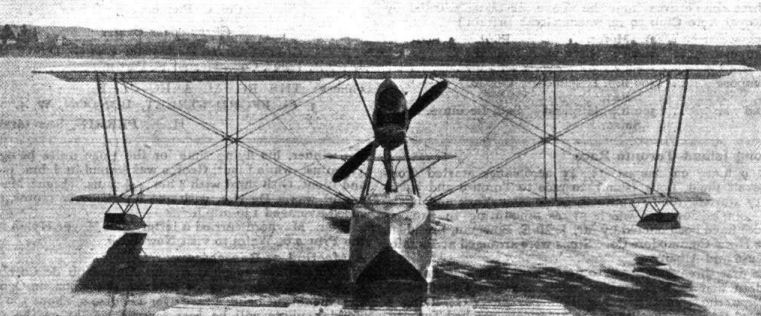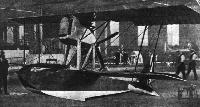D.James Schneider Trophy Aircraft 1913-1931 (Putnam)
Savoia S.13
As a maritime nation it was only natural that Italy would become a very active participant in the Schneider Trophy contests. Its first entrant was the S.13, a modified version of a fast little two-seat bombing and reconnaissance two-bay biplane flying-boat. In only two weeks it was converted to a single-seater, the mainplanes were clipped for racing and converted to single-bay configuration, and the Isotta-Fraschini engine was tuned to produce some ten additional horse power.
The single-step hull was built up from wooden formers and stringers clad with marine plywood. The strut-braced tailplane was mounted on the fin which was an integral part of the hull structure. The wooden elevators and rudder were fabric covered. The straight mainplanes were of conventional two-spar wooden construction with fabricated wooden ribs and fabric covered; the ailerons, fitted only on the upper mainplane, were of similar construction; two small stabilizing floats were strut-mounted under the lower mainplane; and the whole structure was wire-braced. The engine was mounted above the hull on two N-struts, and two other N-struts supported the upper mainplane. The radiator was carried forward of the engine with an oil cooler below it. All flying-control surfaces were cable-operated. The front and lower portion of the engine was cowled with aluminium panels leaving the rear top section uncowled. The engine drove a four-blade wooden pusher propeller in place of the two-blade unit of the military S.13.
When the modifications were completed, the aircraft was dismantled, crated and transported overland by rail and by ship to Britain. Only a few practice flights were possible before the contest in which the S.13, flown by Sgt Guido Jannello, was the only aircraft to complete the required number of laps, but was flown on an incorrect course.
Single-engine racing biplane flying-boat. All-wood construction with wood and fabric covering. Pilot in open cockpit.
One 250hp Isotta-Fraschini Asso 200 six-cylinder water-cooled, direct-drive normally aspirated inline engine driving a 2-1 m (6 ft 11 in) diameter four-blade fixed-pitch wooden propeller.
Span 8-1 m (26 ft 7 in) (upper), 7-28 m (23 ft 11 in) (lower); length 8-3 m (27 ft 3 in); height 3-05m (10ft); wing area 19-6sq m (210-97sq ft).
Empty weight 730kg (1,609 lb); loaded weight 940kg (2,072lb); wing loading 47-96 kg/sq m (9-82lb/sq ft).
Maximum speed 243 km/h (151 mph).
Production - one S.13 converted to single-seat racing configuration by Societa Idrovolanti Alta Italia in 1919.
Colour - overall red with white bottom to hull and stabilizing floats; natural metal engine cowling; green, white and red national stripes on fin and rudder; white-edged black contest number 7 on rudder; blue and white pennant with name Savoia on hull nose.
Savoia S.12bis
Perhaps the S.12 came nearer to Jacques Schneider’s ideals than any other aircraft which participated in the contests. His aim had been to promote the creation of seaworthy long-distance load-carrying maritime aircraft, and the S.12, basically, was all of these, being developed from a two-seat bomber type which had good range and load-carrying characteristics. As the only entry in the 1920 contest to attempt the navigability trials in appalling weather, through which it came with flying colours, this sturdy flying-boat proved its seaworthiness.
In appearance, it was almost identical to the standard S.13 before its conversion to a racing aircraft. The long slender hull was of all-wood construction with a tall curved-back fin and rudder carrying a strut-braced tailplane. A full-width windscreen protected the open cockpit in front of the mainplane. On the standard S.12 the tailplane span was about 4-8 m (16ft) but this was reduced to 2-9 m (9ft 6 in) on the S.12bis racing variant.
The 15-07 m (49 ft 5 in) span mainplanes of the military original also had been reduced, by more than 3 m. A wire-braced two-bay structure, the two-spar mainplanes had plywood ribs giving a markedly curved aerofoil section. Ailerons were fitted only on the upper mainplane and, like the elevators and rudder, were fabric covered. The inboard inter-plane struts were vertical but the outboard struts were canted outward to their upper ends. Two square-section stabilizing floats were strut mounted beneath the lower mainplanes. The 550 hp Ansaldo-San Giorgio twelve-cylinder water-cooled pusher engine was mounted on a pair of N-struts between the mainplanes. A large radiator and integral oil cooler was fitted in front of the engine, the lower portion of which was cowled leaving the top exposed. A second, lighter, pair of N-struts supported the upper mainplane.
Mechanical troubles, transport difficulties and bad weather eliminated all but the S.12 from the list of entries for the 1920 contest at Venice. Having completed the pre-contest trials, Lieut Luigi Bologna had only to fly it over the course to win, which he did at an average of 172-561 km/h (107-224 mph) and secured the Trophy for Italy.
Single-engined racing biplane flying-boat. All-wood construction with wood and fabric covering. Pilot in open cockpit.
One 550 hp Ansaldo-San Giorgio 4E-29 twelve-cylinder water-cooled direct-drive normally-aspirated vee engine driving an Ansaldo four-blade fixed-pitch wooden pusher propeller of about 1-98m (6ft 6in) diameter. Fuel: about 270 litres (60 gal).
Span 11-72m (38ft 5 1/2 in) (upper); length 10m (32ft 10in); height 3-8 m (12 ft 5 1/2 in); wing area 46-52 sqm (500-74 sqft).
Empty weight 1,560kg (3,438 lb); loaded weight 2.360kg (5,202lb); wing loading 50-73 kg/sqm (10-38 Ib/sq ft).
Maximum speed 222km/h (138mph).
Production - believed to be only one S.12bis produced (serialled 3011) by Societa Idrovolanti Alta Italia at Sesto Calende, Italy, in 1920.
Colour - unknown. Carried contest number 7 on side of hull nose and on rudder, S.12 on hull nose and Savoia in large script letters down length of hull.
J.Forsgren Swedish Military Aircraft 1911-1926 (A Centennial Perspective on Great War Airplanes 68)
Savoia S.13
One Savoia S.13 flying boat was donated in November 1919, having been flown to Sweden in company with a Savoia S.9 and a Macchi M.8. Among the Italian pilots were Count di Robilant and Umberto Maddalena. The three Italian flying boats had taken off from Amsterdam on October 19, arriving in the Swedish capitol two days later. On October 24, di Robilant had a lucky escape in the S.13 when he struck power lines near Drottningholm castle. Although the hull was ruptured, the S.13 was towed to Stockholm for repairs. The bad luck for the S.13 did not end there, as the flying boat was struck by a tug boat on November 2. Repaired once again, the S.13 was donated to the MFV on November 9. Initially, the serial number Fb 51 was issued, later being changed to Fb 42.
The Savoia S.13 was considered particularly suitable as a ’’fast reconnaissance and bomber airplane”. In December 1919, an order for three additional S.13s was placed. However, the delivery flight from Varese, Italy to Sweden was fraught with difficulties, with one S.13 being written off and another one damaged. The destroyed airplanes were eventually replaced. The three S.13’s did not reach Sweden until the summer of 1920. The serial numbers 42 to 45 were issued to the S.13’s.
All four S.13’s were damaged in the fire at Galarvarvet on August 5/6, 1921. Although all four were repairable, the entire spares stock had been destroyed, thus limiting their usefulness. One, serial number Fb 45, was cannibalized for spares. Serial number Fb 43 was lost on August 30, 1922, when it crashed off Marsgarn Island in the Stockholm archipelago. Interestingly, the fuselage was later used in the construction of a hydrocopter. Fb 44 was written off on November 7,1922, with the final S.13, Fb 42, lasting until January 1924.
Savoia S.13 Technical Data and Performance Characteristics
Engine: 1 x 250 h.p. Isotta Fraschini V6
Length: 9,9 m
Wingspan: 13,8 m
Height: n/a
Wing area: n/a
Empty weight: n/a
Maximum weight: 1,400 kg
Maximum speed: 197 km/h
Armament: 1x8 mm m/22 machine gun
Журнал Flight
Flight, September 4, 1919.
THE JACQUES SCHNEIDER CUP RACE
The Machines
The Italian Representative
As already mentioned, Italy is to be represented by one machine only, a Savoia flying-boat of the S 13 type, fitted with a 250 h.p. Isotta-Fraschini engine. As the accompanying photograph of the standard S 13 type shows, the Savoia boat is of more or less standard construction and design. The engine is mounted on struts from the boat, and drives a pusher air-screw. The wing bracing is somewhat unusual, being similar to that familiar from the French Spad biplanes. The bracing wires, instead of going to the ends of the first pair of struts, pass through the centres and on to the ends of the outer struts. The intermediate struts are hinged in the centre, and are in the form of steel tubes, while the outer struts are of wood. The following particulars of the Savoia, refer to the standard Type S 13, but it is possible that for the Schneider Race the wing surface may be cut down.
Engine, Isotta-Fraschini V 6, 250 h.p. Length, over all 9.022 metres. Span. 11.8 metres. Wing area, 32.89 sq. m. Weight all on, 1,350 kg. Maximum speed, 206 km. per hour.















